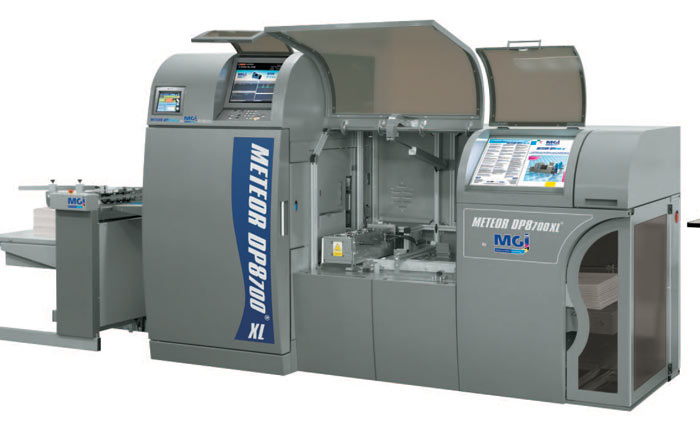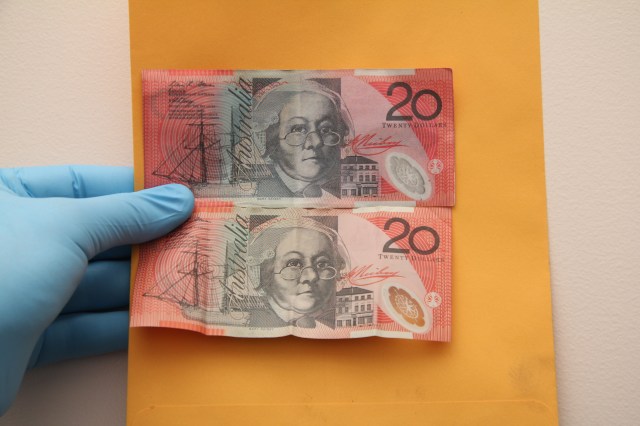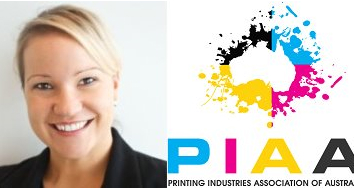
Like a blazing meteor crashing to Earth from a clear night sky at the start of a 1950s sci-fi flick, the arrival of MGI’s Meteor DP8700 XL toner press has left a gaping crater and got the townsfolk talking. Scientists tinkering with the alien projectile have declared: “Look, no click charges!”
The Meteor is not the first digital toner press without click charges. That accolade goes to Xeikon, while Kodak and Heidelberg offered separate consumables and service contracts when they introduced the NexPress. But MGI’s local supplier, Ferrostaal Australia, has made the Meteor’s offset-style cost model a centrepiece of its pitch to print houses.
So will the click charge-free MGI press become a trendsetter? It is certainly pushing against the tide. The click charge holds sway over the digital market. But the business model that links inks, substrates and machine maintenance in a single-cost unit stems from an era when these components were limited in range. With the maturation of toner technologies and the arrival of inkjet as a volume proposition, this is rapidly changing. Some click charge-bound printers are chafing at the collar.
Without a click
US printing industry guru and ProPrint columnist professor Frank Romano says that back in the 1990s, in the early days of B2B digital, when commercial devices were crankier and less predictable and with little choice of inks and papers, manufacturers kept consumables costs and machine service tethered to a flat price per sheet, just as they had in the office market. But there’s a steadily rising outcry from print companies for digital kit that can be bought and operated on an offset-like cost model.
In April, Kosdown Printing in Port Melbourne became the first user of the MGI Meteor in Australia. David Downie had a firm focus on what he wanted from a digital press – rugged build, versatility and a cost structure like an offset press. Is it fair to say the co-director of Kosdown Printing is no fan of click charges? You bet.
ProPrint asked Downie when he thought a click charge model would be suitable. “Never. Our company has been going for 30 years and with our offset machines, we know you don’t make any money on it until you pay it off. Click charges involve leasing and you don’t own the machine.”
Downie, who is co-director of Kosdown with his brother Derek, argues that click charges keep margins artificially high on jobs where the amount of ink coverage does not warrant that cost, thus making it more expensive to produce. “Without click charges, it’s an overhead you don’t have. And if you have to re-do a job occasionally, you don’t want to be passing on click charges to your customer.”
He says Kosdown was impressed with the build of the DP8700 XL. “It’s a sturdy press and you hope to have it for a while, so you want to buy it as you would an offset machine.”
It is also versatile, he says. “We’re using it for a lot more than what we thought we would when it first arrived here, because of the long 1,020mm format. It gives us a lot more flexibility – envelope printing, VDP, a lot of stuff that we’d been sending out to be done, so not having click charges on all that new and different work is a big bonus.”
Click control
Nigel Alexander, Ferrostaal Australia’s general manager of MGI & consumables, acknowledges the market has been educated to accept the simplicity of click-charging. But for commercial printers, there are many advantages to being click charge free, he asserts. “No minimum print volume charges, no monthly contracts, it allows for variable print volume, it enables printers to maintain profitability whatever the page coverage, and it’s designed to resemble an offset print process. The printer purchases ink and consumables as required.
“Printers should be looking for a model that reflects the offset model, the model they have been used to for years. The print production environment is screaming for profitability and cost transparency – let the printers take more control of their costs.”
Continuous-feed inkjet will only hasten the abandonment of click charges, says Alexander. For instance, on p48 of this issue, ProPrint looks at the Graph-Tech MonoCube, another inkjet engine without a click charge.
This is happening as the label market goes inkjet. Digital label printing, as on Screen’s Truepress Jet L350UV, usually carries no click charges. Peter Scott, managing director of Screen Australia, says that while click charges are a known net cost and help profit calculations, “as with locking in home mortgage rates, there is a risk that click rates will drop and a new competitor might be buying at a better rate. It appears that new competitors can also include the press supplier itself, and this is indeed a contentious issue.”
Long live the click
But these voices are in a definite minority. Phillip Rennell, sales & marketing director of HP Indigo supplier Currie Group, believes click charges reflect genuine production cost. “In offset printing, there are costs to produce a job regardless of its run length: making plates, setting the job up on the press, running costs based on length of the job. Some costs are fixed and some are variable. Many customers I talk to handle these calculations differently and they all come up with different numbers.
“The cost can be calculated to the sheet, to the metre, to the job or however the printer wants to do the calculations. This is no different with digital, with the exception of the simplicity and value it provides our customers.
“Click charges provide a simple way for the customer to maintain consignment inventory of consumable items on their site. Under the HP Indigo usage charge agreement, you only pay for what you use,” says Rennell.
Stephen Ball, Fuji Xerox Australia industry marketing manager, says click charges reflect the direct cost of generated print, safeguarding printers from inventories of “lazy asset” consumables not in immediate need.
And while he believes “the renewed debate about the click charge is healthy”, he ultimately sees the alternative time-and-materials model as “compelling as any alternative to a well-established, dominant business model would be”.
That said, Fuji Xerox has a flexible view, now that it is also an inkjet player, with its new compact Fuji Xerox continuous-feed colour inkjet press previewed at PacPrint. Ball says: “In conjunction with Fuji Xerox Finance, we have the flexibility and scale to service and support a number of different business models.”
Kathy Wilson, Ricoh Australia’s general manager of business solutions & production, believes click charges offer advantages. “They give a printer the ability to manage their business effectively, as it allows for accurate accounting of print-related costs before labour and overheads. They also have the peace of mind of a reliable, well-maintained device that is covered by service. With our cutsheet devices, there is a choice of whether or not to include toner. With toner included, printers can adjust their sell price to affect their resulting margin or instead only pay for the cost of toner used.”
Depends on the job
SOS Print & Media director Michael Schulz sees a more complex future. “The inkjets, especially the webfed ones, will have a service charge and the main cost of the page will be in the ink, so everyone now has to re-think. If you quote or make a contract, you have to think what type of work it will be: will it be a lot of ink or not so much? Some jobs make more sense on a device with a click charge and often it will make more sense just to pay for the consumables. But it’s certainly getting more complicated.”
The Sydney company runs digital production lines on both cost models. It has a click charge-free Xeikon press, paying only for toner, and a similar model for its black-and-white inkjet Kodak Prosper 1000. But its Ricoh and HP Indigo machines are on click charges. Schulz says: “Not having click charges is great if you have work that gives you low ink coverage, but it’s not so great if you’re doing full-bleed images.
“You have to calculate your cost and if the customer wants a predictable rate, you have to offer them the choice of either click charges or no click charges. If it’s consumable charges, you have to find out what kind of work it is, not just the pagination. You have to find out how much ink will be used. On university print, for example, with pages that are mainly colour at the top and bottom with mostly black text on the page, you’d be better off to pay the consumables, but if you’re doing full-bleed photobooks, then you’re better off with click charges.”
What’s the problem?
Mike Jones can’t understand the fuss of the anti-click charge brigade. The managing director of 17-year-old Sydney cutsheet digital provider Corporate Document Management (CDM) believes any PSP would want to lock in the maintenance of its digital kit. “A scratch on a belt can set you back $2,500.”
Moreover, he sees click charges as an unavoidable cost component of a quality-driven business. CDM specialises in training and education materials and offers print-on-demand and pick-and-pack services. Jones deliberately steers clear of super-high volume projects, and for that reason alone, he is not interested in commercial inkjet.
He believes in laser-toner technologies. CDM’s production floor includes three Xerox Nuvera 288s, an iGen3, a DocuColor 8000 and a DocuColor 5252. Typical jobs are in “tens of thousands, but not millions” of impressions. “A good volume, but not what I’d call high.”
“The click charge is the cost of running a digital business. The click charge should be irrelevant. If the click charge in your business has validity, you’re frankly on your last legs. If I concern myself about click charges, I’m in the wrong business.”
Jones says a click charge-free digital environment is the pipe dream of margin-slashers who plot to survive by competing on price.
“A lot of former offset-only businesses are entering the digital domain and bringing their offset-selling philosophies with them. They want to calculate their cost of production and add a mark-up and hope it will be lower than their competitors and draw in the work.”
The reality is that this model no longer works well in offset and not at all in digital, he argues, which is why some declining litho outfits – faced with losing chunks of their business to electronic media – are knocking on the digital door.
They hope to re-establish their price-volume matrix in the digital production realm, and are understandably drawn to messages about click charge-free operations. But in digital, it should not be about price, argues Jones.
“You need to upsell. With digital, you have to offer value and service to your customers. You want to establish relationships and cultivate return business, and make sure your customers are happy with the services you provide, not sell on price. Look what happened to Geon.”
Keeping the lid on click charges
There are many remedies for corralling click charges:
• Software vendors market preflighting PDFs with the promise of less wastage and hence fewer click charges
• On many sheetfed digital machines, both A4 and A3 sheets count as one click and some users place two A4s on one A3
• When embellishing certain jobs, maximising click charges is not the best model. Printers typically gang the maximum number of business cards on one sheet to minimise click charges. But dies are much more expensive. It’s more cost-effective to gang fewer cards and reduce the number of dies needed.
Comment below to have your say on this story.
If you have a news story or tip-off, get in touch at editorial@sprinter.com.au.
Sign up to the Sprinter newsletter


